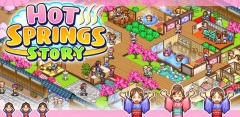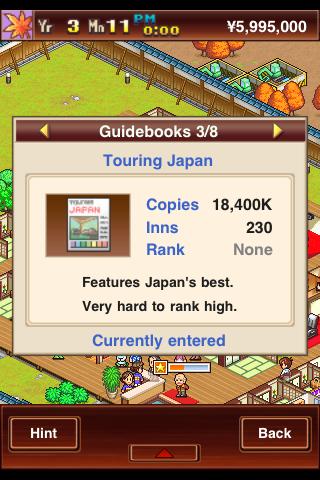Hot Springs Story
| Hot Springs Story | |
|---|---|
 |
|
| Platforms | Android, iOS |
| Genre | Relaxing simulation |
| Score | 8  |
Game Dev Story was kind of a perfect storm video game for me. It combined my love for deep simulations with game development and threw in some lovely pixel art to top it all off. Hot Springs Story is Game Dev’s successor, and while I have been in hot springs in Japan, I had little interest in managing one. But since this is Kairosoft and knowing how much I enjoyed developing games within a game, I had to jump at it.
While I originally played Game Dev Story on an iPod Touch, I played Hot Springs Story on an Android EVO 4G. It has a much larger and better looking screen, which is great because Hot Springs Story does a much grander job taking advantage of all the screen real estate available.
Let’s get into my review of Hot Springs Story, developed by Kairosoft for Android and iOS.
First of all, yes, this game is about managing a hot spring in Japan. The simulation genre shouldn’t really surprise anyone anymore, we’ve managed and built prisons, hospitals, the afterlife, and even farmed, so running an onsen almost seems tame.
Second of all, this is not a Sally Spa ripoff where you’re Burger Timing every user who comes in for a pedicure. Nor is this really like Game Dev Story, where you stare at a pretty static view of your developers as they Team Bondi their way to the next AAA title (too soon?). Hot Springs Story is almost like a zoomed in version of SimCity, where you carefully layout your zones (baths, hotel rooms), connect them with roads (hallways), and support them with public services (vending machines and entertainment).
It’s a surprisingly deep execution, too. There are dozens of different types of people to attract and please (called “targets”), a heavy emphasis on scenery to increase the popularity of certain rooms, and compatibility between different rooms being placed near each other. You’re actually scored at the end of the game on how many different targets you unlocked and how many different room compatibilities you discovered, Hot Springs Story is constantly encouraging you to branch out and uncover new things.
The basic elements of the game are the land you own to build your inn on, the different rooms you can place along with surrounding plants, and the various people you can attract to your inn. You start out with a relatively small piece of land, but can buy the immediate surrounding area as you earn more money. You also start with just a simple tatami mat hotel room with a men’s and women’s bath, but by the end of the game you’re placing down fortune tellers and table tennis gyms. And as for the people, the game hits that range too, featuring everyone from students and seniors, to CEOs and noblewomen.
You attract more people to your inn by building the popularity of rooms, this is generally done by placing compatible rooms near each other (such as a restaurant and western style hotel room) and by building up the surrounding scenery. You’re able to see all the exact numerical effect of everything you do, so maximizing potential is not only a must, but expected.
As your early inn goers begin to “level up” by having a good time at your inn, they make investments available to you. An investment can be something like giving $2000 to a local comic book store, which upon completion opens up a new cartoonist target. The cycle repeats and your resort becomes more and more popular with different segments of the population.
Completing investments also unlocks new rooms, or provides you with sort of a challenge guest who must reach 100% satisfaction before they leave. There’s also the constant goal of competing in guidebook rankings. You start off entering yourself in the local guidebook, and by the end of the game you’ll be shooting for number one in the entire world.
Graphically, Hot Springs manages to improve over Game Dev Story, mostly because the pixel art expands to use the entire screen this time, and landscape mode is also fully supported. Each character has a unique head to distinguish what kind of target they are, and the animations are simple enough to be cute and bearable to look at hundreds of times. There is also a ton more real estate to look at in Hot Springs, instead of just the static view of your studio in Game Dev. I wasn’t a fan of the music though, it’s basically just the same ten second ditty on loop.
My major complaint is that Hot Springs Story can just run on auto-pilot most of the time. Games like SimCity were constantly challenging you with either disasters or changing economic woes and demand for different zones. In Hot Springs, happiness and success goes in one direction: up. If you didn’t have to acknowledge a pop-up every once in a while, you could let the game run for hours and simply rack up cash and popularity.
This is also a pretty big change from Game Dev Story, which required your constant input on developing new games, but like I said in the introduction, these games are on pretty different paths of the simulation genre.
Another issue is that this is obviously a port to the Android platform from iOS, as the game doesn’t take advantage of the extra buttons such as Menu or Back. Hitting the Menu button doesn’t do anything, but hitting the game’s Menu button opens the menu. Little things like that detract from the overall experience.
Finally, something that bugged me quite a bit throughout the game was how to boost a bath’s bonus features. To increase compatibility with Adults, you can build two pachinko machines, a massage chair, and a lantern near a bath. This will give it “one heart” in its Spa value. But it took me nearly the rest of the game to understand how to get the second and third points: you just have to build another whole set of pachinko machines, etc. So to get three points in Spa, you need to have six pachinko machines, three massage chairs, and three lanterns completely surrounding the bath. This looks absolutely ridiculous and most of these facilities go completely unused. Would have liked a more elegant way to boost stats instead of just building up junk around the bath.
Hot Springs Story is one of those great “just one more turn” kind of games. There is always another target available to level up, an investment to throw your money at, or scenery to improve. The graphics are pixel perfect gorgeous, but the music is rather repetitive. More interaction would have been a blessing, too. Your inn can run almost completely autonomously without you, with you basically acting as the checkbook ready to expand at your desire.
If you’ve played Game Dev Story, Hot Springs is the obvious next step. If you’re into the simulation genre in general, check out both of these games, and hopefully look for my review of Grand Prix Story in the near future.
Final Stats at 15 Years
- Final Money: $78051
- Compatibility Guide: 17
- Investments: 47
- Targets: 36
- Guests: 2664
- Inn Popularity: 245
- Trophies: 7
- Total: 212960 points



